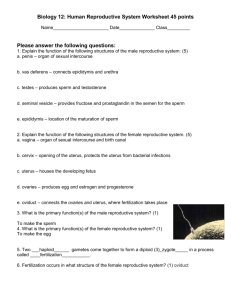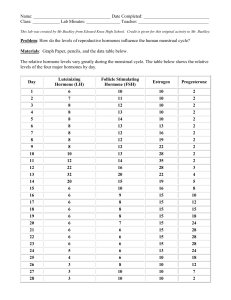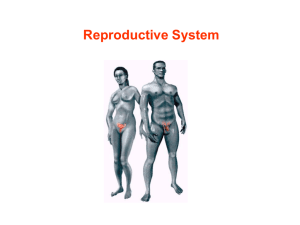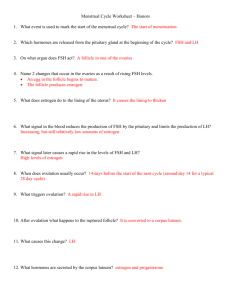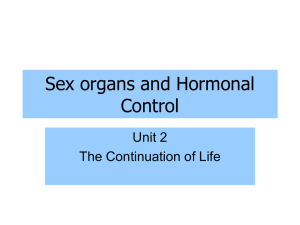Chapter 17 The Reproductive System Replacement & Repair
advertisement
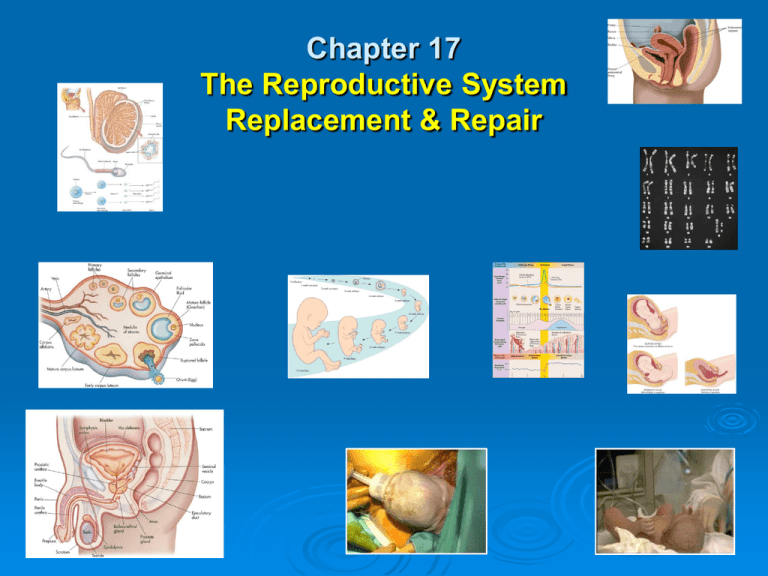
Chapter 17 The Reproductive System Replacement & Repair Introduction Purpose of Reproduction Mitosis or Asexual reproduction: Tissue Replacement Regeneration of Tissues Cells & tissues get damaged or simply wear out. The process by which cells make exact copies of themselves, & is essential to maintain a healthy body. Meiosis: To reproduce human life Mitosis vs Meiosis Mitosis: Cells make identical copies of themselves Human cells are called Eukaryotic cells Contain bundles of chromatin (chromosomes) #46 Bacteria are single-cell Prokaryotic cells & divide via Binary Fission. Prophase Metaphase Anaphase Telophase & Cytokinesis Meiosis Gametes: Sex cells; female eggs & male sperm for human or animal reproduction. Formed in Gonads: Ovaries & Testes Total number of chromosomes needed is 46, 23 from mother & 23 from father. Daughter Cells: produced at end of meiosis have half as many chromosomes (23) as original. Chromosomes are matched based on size, shape, & genes they carry & numbered 1-23. Meiosis 23rd pair: is sex chromosome determines sex of baby. XX is female, XY is male; thus the father determines sex of the baby because the mother can only contribute “X” chromosomes. Sexual Reproduction Fertilization: both male & female gametes unite & combine their genetic material; thus fertilization. Zygote (fertilized egg), has 46 chromosomes; reproduces millions of times via mitosis & develops within female to change from embryo to fetus. The Early Stages of the Human Life Cycle Day 1: Fertilization in Fallopian tube Week 1-3: Zygote in Fallopian tube Weeks 3-9: Embryo implantation in uterus Week 10: Fetus placenta with umbilicus formed Month 9: Infant birth The Human Reproduction System Female Anatomy Reproductive organs called genitalia Divided into: Primary genitalia: gonads (Ovaries) that produce gametes. Secondary genitalia: other structures that aid in reproductive process; fallopian tubes, uterus, vagina, & external genitalia called vulva. The Ovary Covered by fibrous capsule called tunica albuginea made of cuboidal epithelium. Cortex: contains eggs (gamates) Medulla: contains blood vessels, nerves, & lymphatic tissue surrounded by loose connective tissue. The Uterine Tubes Called oviducts or fallopian tubes, are 4 inch passageways for eggs to get to uterus. Infundibulum: large funnel, surrounded by ciliated projections called fimbria. Connected to superior portion of uterus Made of smooth muscle, ciliated simple columnar epithelium tissue. Covered by visceral peritoneum & suspended by mesentery known as mesosalpinx, Latin for tuba!!! The Uterus Found in pelvic cavity posterior and superior to urinary bladder & anterior to rectum. Major portion called “body.” Fundus: rounded superior portion between uterine tubes. Isthmus: narrow inferior portion Cervix: “valve-like” portion of uterus that protrudes into vagina. Cervical Canal: communicates with vagina Uterine Layers Perimetrium: outermost layer Myometrium: smooth muscle Endometrium: highly vascular inner lining is mucosal layer of columnar epithelium & secretory cells with two divisions; 1. Basal: responsible for regenerating uterine lining each month. 2. Functional: sheds about every 28 days during menses. Pathology Connection: Endometriosis Etiology: endometrial tissue escapes uterus & implants in abdominal cavity. Builds up & decays each month with hormonal changes. S/S: Chronic pelvic pain dysmenorrhea: pain during menstruation dyspareunia: painful sexual intercourse Dysuria: painful urination Endometriosis con’t DX: history & physical exam ultrasound laparoscopic surgery Rx: NSAIDs surgical removal of tumors Hormones: progesterone, GnRH agonists, androgens (testosterone). Hysterectomy The Vagina 10 cm (4 inches) long running from uterus to outside of body. Purpose: To receive penis during intercourse Allow for passage of menstrual fluid out of uterus Also called birth canal, to allow movement of baby out of uterus during childbirth. Opening may be covered a perforated membrane, the hymen. The External Genitalia (Vulva) Labia majora: rounded fat deposits that meet & protect rest of external genitalia. meet anteriorly to form “mons pubis” Pudendal cleft: Open area between the 2 labia majora The External Genitalia (Vulva) con’t Perineum: Area between vagina & rectum Labia minora: (prepuce) Meet anteriorly to form the prepuce Clitoris contains erectile tissue 2cm in diameter Mammary Glands Milk production glands housed in breasts In young children virtually identical in boys & girls At puberty estrogen & progesterone stimulate breast development in girls. Lactation In adult females, breast consists of 15-20 glandular lobes & “adipose” tissue. Each lobe divided into smaller lobules which house milk secreting sacs called alveoli when woman is “lactating.” Milk travels through series of ducts & sinuses, eventually reaching areola or nipple. Milk production controlled by hormone “prolactin” The Menstrual Cycle Organized around approximately 28 days, involves ovaries & uterus. Ovarian cycle involves monthly maturation & release of eggs from ovary. Uterine cycle consists of monthly buildup, decaying, & shedding of uterine lining. The Menstrual Cycle con’t Cycles begin in teen years during puberty, & end during her 40s or 50s in menopause. Goal is to release egg for fertilization, prepare uterus to receive fertilized egg, & nourish fertilized egg should pregnancy result. If pregnancy doesn’t result, uterine lining will shed & cycle will begin again! The 28-day Menstrual Cycle Begins with first day of menses Menstruation refers to actual shedding of endometrium, “period” itself. Menses usually lasts 4–5 days, but can be longer or shorter in different women, can vary month to month. The 28-day Menstrual Cycle The 1st of 4 Stages of Menses Follicle Stage: 10 days long FSH released Follicle & ovum mature Estrogen released (ovary) Uterine lining prepared The 2nd of 4 Stages of Menses Ovulation Stage: FSH stops LH starts: triggers ovulation Day 14 Follicle ruptures Ovum released The 3rd of 4 Stages of Menses Corpus Luteum Stage: Progesterone released (ovary & endometrium) If egg fertilized, progesterone cont 14 days long The 4th of 4 Stages of Menses Menstruation Stage: If no egg fertilized, 3-6 days of diminished production of progesterone. Uterine lining broken down Oogenesis, Follicle Development, & Ovulation Oogenesis: Process of egg production Begins with birth of Oogonia, or egg stem cells, in ovary. Oogonia undergoes mitosis, producing millions of “primary oocytes”. Women will have all eggs they will ever have 5 months before they are born. Primary Oocytes Born via mitosis: still have 46 chromosomes Must undergo meiosis to become gametes, with only 23 chromosomes, allowing them to combine with another gamete (sperm) & ending with total of 46 chromosomes. Primary oocytes stay in kind of suspended animation until puberty, when they finish developing. Follicle Development Primary oocytes eventually surrounded by helper cells, called granulosa cells; at this point they are called primordial follicles, & stay “dormant” until puberty. Hormonal signals during puberty cause some primordial follicles to enlarge & increase number of granulosa cells. Enlarged cells called “primary follicles” Ovulation @ puberty, one primary follicle will become “secondary” follicle. Secondary follicle: will not complete development unless it is ovulated & fertilized. Just before ovulation: secondary follicle fills with fluid & moves toward surface of ovary, where it becomes a visible lump. Ovulation con’t Fimbria of uterine tubes brush surface of ovary, causing follicle to rupture. When follicle ruptures: egg (actually an oocyte) is released into peritoneal cavity & fimbria pull it toward funnel, drawing it into uterine tube. (Wow!!!) Ovulation con’t Ova travels down Fallopian tube If sperm present in uterine tube & all conditions are right, sperm will penetrate egg, fertilizing it & triggering rest of egg development. If ova is fertilized… Now called “zygote” with 46 chromosomes Zygote enters uterus & implants into proliferated “endometrium,” stopping woman from experiencing menses. Ruptured follicle left behind in ovary will become “corpus luteum” and secrete hormones to help maintain thickened endometrium to nourish embryo. If ova is NOT fertilized… zygote will not implant in uterus Within few days, uterine lining will begin to degenerate & woman will have her period, with egg swept out in menstrual flow. Corpus luteum will become corpus albicans & eventually disappear. Hormonal Control Hormones from hypothalamus, pituitary, & ovary control female cycle. Generally controlled by negative feedback loop. Released as part of hierarchy, with hypothalamus releasing hormone that controls pituitary, which then releases hormone that controls another organ. The 4 hormones that control menstrual cycle Ovary: Estrogen & Progesterone Pituitary: Luteinizing hormone (LH) & Follicle Stimulation Hormone (FSH). Estrogen & progesterone levels: increase at puberty. Gonadotropin releasing hormone (GnRH) from hypothalamus causes increase in secretion of LH & FSH from pituitary. Hormonal Control con’t During Follicular stage: FSH initiates development of primary follicles each month, while LH triggers ovulation. Estrogen levels continue to rise as more & more is secreted by developing follicle, stimulating proliferation of uterine lining. Estrogen exerts positive influence on hypothalamus, increasing secretion of GnRH, thus increasing LH & FSH. + feedback loop continues, raising hormone levels until ovulation occurs. Hormonal Control con’t Once ovulation occurs, feedback loop reverses itself. Corpus luteum begins to secrete progesterone, as well as a little estrogen. Estrogen under influence of progesterone, exerts neg. feedback on hypothalamus & pituitary, decreasing GnRH, LH, & FSH secretion. Hormonal Control con’t Progesterone also exerts negative feedback on hypothalamus & pituitary. Thus, LH, FSH, & estrogen levels drop while progesterone levels rise. Hormonal changes prevent another egg from maturing. Hormonal Control con’t For about 10 days after ovulation, progesterone levels remain high as corpus luteum continues to secrete hormone. Progesterone's effect on uterus is to maintain buildup of endometrium & to decrease uterine contractions. If no pregnancy results, corpus luteum degenerates & progesterone will no longer be produced. Hormonal Control con’t Decreasing progesterone levels cause degeneration of endometrium, followed by menstruation. Decreased progesterone levels release hypothalamus & pituitary from its inhibitory effects, & FSH & LH levels begin to rise & cycle begins again. If pregnancy occurs… Implanted fertilized egg secretes hormone called human chorionic gonadotropin (HCG). HCG stimulates corpus luteum to keep secreting progesterone & little estrogen to maintain uterine lining. @ about three month’s gestation, placenta begins to secrete its own progesterone & estrogen, thus becoming endocrine organ!!! If pregnancy occurs… con’t… Prolactin: produced by anterior Pituitary stimulates milk production by breasts. Oxytocin: produced by posterior Pituitary stimulates uterine contractions & milk production. Pathology Connection: Menstrual Disorders Premenstrual Syndrome: Etiology: central-nervous-system neurotransmitter interactions with sex hormones affected??? S/S: depression, anger, irritability, anxiety, confusion, withdrawal, breast tenderness, bloating, swelling extremities, headache. D/X: must start 5 days prior to menses, cease 4 days into menses, & not recur until following cycle; X 3 cycles. Premenstrual Syndrome con’t Rx: Mild/moderate: good nutrition, regular exercise, complex carbohydrates, calcium supplements. NSAID or hormonal suppression Severe: psychiatric medications Polycystic Ovarian Syndrome Etiology: Ovaries produce too much testosterone & estrogen, but too little progesterone, effects 5-10 % women. S/S: • • • • • • • • • Failure to ovulate Excess facial hair Male pattern baldness Irregular menstrual cycles Formation of multiple cysts on ovaries Hormonal abnormalities Infertility Obesity Insulin resistance (Type II DM) Polycystic Ovarian Syndrome con’t D/X: Serum analysis; looking for elevated levels of LH, testosterone, prolactin, insulin. Ultrasound: looking for large ovaries Rx: consists mainly of symptom relief • • • • Weight loss Birth control pills: can regulate menstrual cycle Drugs: can treat hyperlipidemia & DM Infertility drugs &/or surgical repair of damaged ovaries. Polycystic Ovarian Disease Breast Cancer Etiology: most common malignancy of American women and leading cause of death between ages 40-55; familial history S/S: bloody, brown, or serous nipple discharge, noticeable lump, changes in breast tissue DX: mammogram, Imaging, biopsy TX: lumpectomy, mastectomy, chemotherapy, radiation, etc Cervical Cancer DX: PAP smears with microscopic examination, patient history and exam. TX: cryotherapy (freezing) or laser surgery, hysterectomy (removal of uterus); radiation Male Anatomy Testes: primary genitalia: producing male gamete, sperm secondary genitalia: penis (sperm delivery organ), epididymis, vas deferens, urethra, prostate gland, seminal vesicles, & bulbourethral glands. The Testes con’t Paired organs: suspended in sac called scrotum, hanging on either side of penis. During fetal development, testes formed in abdomen; in last 3 months of development, migrate to normal position in scrotum. Pathology Connection: Cryptorchidism Testes fail to descend into scrotal sac Requires surgical intervention: Orchiopexy May become sterile as abdominal temp too warm Cryptorchidism Orchiopexy Pathology Connection: Hydrocele Etiology: abnormal collection of fluid around testes via inguinal hernia. S/S: scrotal edema, possible pain, deformity Dx: transillumination, ultrasound Rx: Hydrocelectomy Pediatric Hydrocele Ultrasound Pathology Connection: Testicular Torsion Etiology: twisting of the vas deferens, which cuts off the blood supply to the testicle. S/S: sudden onset of pain, edema, N/V, rise in level of affected testicle. Dx: H/P, ultrasound Rx: emergency Orchiopexy Prog: good if surgery done within 6 hours of pain The Penis Latin word for “tail” Sperm delivery organ that transfers sperm from male to female. Attached portion called root, while freely moving part called shaft or body. Glans penis (tip) is covered by loose section of skin called foreskin or prepuce unless man has been circumcised. The Penis cont. Contains urethra, a transport passage for both sperm & urine. Has 3 erectile bodies, tubes with sponge-like network of blood sinuses. Glans: Head of penis Corpus cavernosum: 2 columns of tissue running along the sides of the penis. Blood fills this tissue to cause an erection. Corpus spongiosum: column of sponge-like tissue running along front of penis ending at glans penis; fills with blood during erection. The Epididymis Comma shaped duct on posterior and lateral part of testes Tube is highly coiled, if unraveled, would measure six meters long Sperm mature here The Vas Deferens Short tube: 45 cm long Runs from anterior part of scrotum as pair of tubes, one on each side, into abdominal wall and pelvic cavity, medially over urethra, and along posterior bladder wall Posterior to bladder, joins seminal vesicle to form ejaculatory duct, which then passes through prostate gland and empties into urethra Three Accessory Glands Seminal vesicles: highly coiled, posterior to bladder Prostate gland: chestnut-sized gland surrounding urethra just inferior to bladder Bulbourethral glands: pea sized glands inferior to prostate Pathology Connection: Male Reproductive Diseases Benign Prostatic Hyperplasia (BPH) Etiology: Non-cancerous enlargement of prostate S/S: enlarged prostate impinges upon urethra, causing • • • • • Weak urine stream Incomplete voiding Urinary frequency Night time urination Urinary urgency Benign Prostatic Hyperplasia (BPH) cont. DX: • History and physical exam (including exam of prostate) • Prostate specific antigen (PSA) blood levels • Rule out other urinary conditions (like infection, etc.) Benign Prostatic Hyperplasia (BPH) cont. TX • Drug tx: decrease testosterone and shrink prostate; relax smooth muscle in prostate, improving urine stream • Surgical tx: minimally invasive laser or microwave ablation. placement of stent in urethra, removal of part or all of prostate Benign Prostatic Hyperplasia Prostate Cancer Etiology: cancer cells forming in prostate; most common non-skin cancer affecting American men S/S: same as BPH DX: Physical exam and prostate specific antigen (PSA) blood test can be used to screen for it TX: chemo, radiation, surgery Spermatogenesis Produced in testes beginning when boy reaches puberty and continuing until death Sperm stem cells, undergo mitosis to form primary spermatocytes Primary spermatocytes form two secondary spermatocytes Spermatocytes complete meiosis to form spermatids Spermatogenesis cont. Spermatids go through period of development to form immature spermatozoa (sperm) All of this takes place in testes in seminiferous tubules Sperm then travel from seminiferous tubules to epididymis where sperm spend about two weeks maturing and gaining ability to swim Spermatogenesis Hormonal Control of Male Reproduction At puberty, two hormonal changes occur First, testosterone secretion by testes increases Second, testosterone inhibits GnRH, FSH and LH, further enhancing testosterone production, creating major positive feedback loop Hormonal Control of Male Reproduction cont. Testosterone secretion at puberty brings about male secondary sexual characteristics development including: Body, facial, and pubic hair growth Deepening of the voice Increased muscle and bone mass Erection and Ejaculation Erectile bodies in penis become engorged with blood, producing erection During ejaculation sperm is propelled from epididymis into vas deferens, and into pelvic cavity As sperm passes seminal vesicles sugar and chemicals added Erection and Ejaculation cont. Sperm and chemicals enter ejaculatory duct, pass through prostate gland, where fluid is added, liquefying semen and protecting sperm from acid environment of vagina by secreting alkaline substance Semen passes by bulbourethral gland, adding mucus to semen Finally, semen enters urethra and is carried outside body Pregnancy Period of time when developing baby grows within uterus called gestation period, approximately 40 weeks Baby born before 37 weeks gestation considered premature First eight weeks of gestation developing fertilized egg called embryo; organs and systems are fundamentally formed Pregnancy cont. After eight weeks is called fetus fetus nourished by spongy structure called placenta, attached to fetus and mother by umbilical cord Fetus is encased in membranous sac, called the amnion, containing amniotic fluid Amniocentesis Stages of Labor Stage 1: dilation- uterine smooth muscles begin to contract, moving fetus down uterus and causing cervix to begin to dilate. Stage 2: expulsion- begins when cervix fully dilated to 10 cm and fetus actually delivered; breech presentation is when buttocks or foot appear first instead of head. Stage 3: placental- delivery of placenta from final uterine contractions. Stages of Labor Pregnancy/Delivery complications: Abruptio Placenta Etiology: placenta separates from uterus S/S: bleeding, pain, preterm labor DX: ultrasound TX: depends on severity: ranges from nothing to emergency caesarian section Placenta Previa Etiology: placenta grows over cervix; causes unknown S/S: bleeding late in pregnancy, pain DX: ultrasound TX: transfusions, medication, caesarian Ectopic (tubal) pregnancy embryo implants in uterine tube Etiology: scarring, endometriosis S/S: bleeding, abdominal pain, nausea, unconsciousness and shock if tube ruptures DX: ultrasound, exploratory surgery, blood tests, pregnancy test TX: termination of pregnancy, treatment of symptoms Postpartum Depression Etiology: changes in hormone levels after pregnancy S/S: fatigue, anxiety, worthlessness DX: exam TX: counseling, medication

